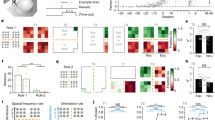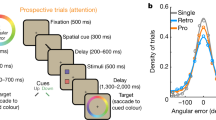Abstract
Although it has long been thought that the prefrontal cortex of primates is involved in the integrative regulation of behaviours1,2,3,4, the neural architecture underlying specific aspects of cognitive behavioural planning has yet to be clarified5,6,7,8. If subjects are required to remember a large number of complex motor sequences and plan to execute each of them individually, categorization of the sequences according to the specific temporal structure inherent in each subset of sequences serves to facilitate higher-order planning based on memory. Here we show, using these requirements, that cells in the lateral prefrontal cortex selectively exhibit activity for a specific category of behavioural sequences, and that categories of behaviours, embodied by different types of movement sequences, are represented in prefrontal cells during the process of planning. This cellular activity implies the generation of neural representations capable of storing structured event complexes at an abstract level, exemplifying the development of macro-structured action knowledge in the lateral prefrontal cortex9.
This is a preview of subscription content, access via your institution
Access options
Subscribe to this journal
Receive 51 print issues and online access
$199.00 per year
only $3.90 per issue
Buy this article
- Purchase on Springer Link
- Instant access to full article PDF
Prices may be subject to local taxes which are calculated during checkout



Similar content being viewed by others
References
Fuster, J. M. The Prefrontal Cortex (Raven, New York, 1989)
Goldman-Rakic, P. S. in Handbook of Physiology: The Nervous System (ed. Kandel, E. R.) 373–417 (American Physiological Society, Bethesda, Maryland, 1987)
Miller, E. K. & Cohen, J. D. An integrative theory of prefrontal function. Annu. Rev. Neurosci. 24, 167–202 (2001)
Shallice, T. & Burgess, P. W. The domain of supervisory processes and temporal organization of behaviour. Phil. Trans. R. Soc. Lond. B 351, 1405–1411 (1996)
Grafman, J. Similarities and distinctions among current models of prefrontal cortical functions. Ann. NY Acad. Sci. 769, 337–368 (1995)
Passingham, P. E. The Frontal Lobes and Voluntary Action (Oxford Univ. Press, Oxford, 1993)
Tanji, J. & Hoshi, E. Behavioral planning in the prefrontal cortex. Curr. Opin. Neurobiol. 11, 164–170 (2001)
Koechlin, E., Ody, C. & Kouneiher, F. The architecture of cognitive control in the human prefrontal cortex. Science 302, 1181–1185 (2003)
Wood, J. N. & Grafman, J. Human prefrontal cortex: processing and representational perspectives. Nature Rev. Neurosci. 4, 139–147 (2003)
Shima, K. & Tanji, J. Neuronal activity in the supplementary and presupplementary motor areas for temporal organization of multiple movements. J. Neurophysiol. 84, 2148–2160 (2000)
Saito, N., Mushiake, H. & Tanji, J. Representation of immediate and final behavioral goals in the monkey prefrontal cortex during an instructed delay period. Cereb. Cortex 15, 1535–1546 (2005)
Green, D. M. & Swets, J. A. Signal Detection Theory and Psychophysics (Wiley, New York, 1966)
Nieder, A. & Miller, E. K. A parieto-frontal network for visual numerical information in the monkey. Proc. Natl Acad. Sci. USA 101, 7457–7462 (2004)
Mushiake, H., Inase, M. & Tanji, J. Selective coding of motor sequence in the supplementary motor area of the monkey cerebral cortex. Exp. Brain Res. 82, 208–210 (1990)
Nakamura, K., Sakai, K. & Hikosaka, O. Neuronal activity in medial frontal cortex during learning of sequential procedures. J. Neurophysiol. 80, 2671–2687 (1998)
Tanji, J. & Shima, K. Role for supplementary motor area cells in planning several movements ahead. Nature 371, 413–416 (1994)
Tanji, J. Sequential organization of multiple movements: involvement of cortical motor areas. Annu. Rev. Neurosci. 24, 631–651 (2001)
Procyk, E., Tanaka, Y. L. & Joseph, J. P. Anterior cingulate activity during routine and nonroutine sequential behaviors in macaques. Nature Neurosci. 3, 502–508 (2000)
Isoda, M. & Tanji, J. Contrasting neuronal activity in the supplementary and frontal eye fields during temporal organization of multiple saccades. J. Neurophysiol. 90, 3054–3065 (2003)
Barone, P. & Joseph, J. P. Prefrontal cortex and spatial sequencing in macaque monkey. Exp. Brain Res. 78, 447–464 (1989)
Averbeck, B. B., Chafee, M. V., Crowe, D. A. & Georgopoulos, A. P. Neural activity in prefrontal cortex during copying geometrical shapes. I. Single cells encode shape, sequence, and metric parameters. Exp. Brain Res. 150, 127–141 (2003)
Averbeck, B. B., Sohn, J. W. & Lee, D. Activity in prefrontal cortex during dynamic selection of action sequences. Nature Neurosci. 9, 276–282 (2006)
Koechlin, E. & Jubault, T. Broca’s area and the hierarchical organization of human behavior. Neuron 50, 963–974 (2006)
Zalla, T., Pradat-Diehl, P. & Sirigu, A. Perception of action boundaries in patients with frontal lobe damage. Neuropsychologia 41, 1619–1627 (2003)
Sirigu, A. et al. Planning and script analysis following prefrontal lobe lesions. Ann. NY Acad. Sci. 769, 277–288 (1995)
Sirigu, A. et al. Selective impairments in managerial knowledge following pre-frontal cortex damage. Cortex 31, 301–316 (1995)
Duncan, J. An adaptive coding model of neural function in prefrontal cortex. Nature Rev. Neurosci. 2, 820–829 (2001)
Dominey, P. F., Lelekov, T., Ventre-Dominey, J. & Jeannerod, M. Dissociable processes for learning the surface structure and abstract structure of sensorimotor sequences. J. Cogn. Neurosci. 10, 734–751 (1998)
Freedman, D. J., Riesenhuber, M., Poggio, T. & Miller, E. K. Categorical representation of visual stimuli in the primate prefrontal cortex. Science 291, 312–316 (2001)
Miller, E. K., Freedman, D. J. & Wallis, J. D. The prefrontal cortex: categories, concepts and cognition. Phil. Trans. R. Soc. Lond. B 357, 1123–1136 (2002)
Acknowledgements
This work was supported by a Grant-in-Aid for Scientific Research on Priority Areas from the Ministry of Education, Culture, Sports, Science and Technology of Japan.
Author Contributions K.S. and J.T. performed all aspects of the study, including the design of the experiment, collecting and analysing the data, and writing the manuscript. M.I. assisted in experimental design and in collecting the data. H.M. assisted in data analysis and manuscript preparation.
Author information
Authors and Affiliations
Corresponding author
Ethics declarations
Competing interests
Reprints and permissions information is available at www.nature.com/reprints. The authors declare no competing financial interests.
Supplementary information
Supplementary Information
This file contains Supplementary Methods, Supplementary Figures 1-6 with legends, and Supplementary Data. Figure 1 is for a schematic of the main finding, and Figure 2 is for illustrating the behavioral task. The supplementary Figures 3 and 4 collectively show that the variations of preparatory activity of each PF cell for sequences belonging to one category were small, whereas the variations for sequences belonging to different categories were large. The supplementary Figure 5 shows how the category selective activity developed during performance of successive trials. The Supplementary Figure 6 presents the category selectivity during the time epoch preceding the preparatory period. Finally, the Supplementary Data includes information about the behavioral data for error trials, results of analysis on 21 cells during performance of error trials, the comparison of data obtained in dorsal and ventral PF, and the category selectivity during the inter-trial interval. (PDF 891 kb)
Rights and permissions
About this article
Cite this article
Shima, K., Isoda, M., Mushiake, H. et al. Categorization of behavioural sequences in the prefrontal cortex. Nature 445, 315–318 (2007). https://doi.org/10.1038/nature05470
Received:
Accepted:
Published:
Issue Date:
DOI: https://doi.org/10.1038/nature05470
This article is cited by
-
Rational arbitration between statistics and rules in human sequence processing
Nature Human Behaviour (2022)
-
Do we understand the prefrontal cortex?
Brain Structure and Function (2022)
-
Effects of dorsolateral prefrontal cortex lesion on motor habit and performance assessed with manual grasping and control of force in macaque monkeys
Brain Structure and Function (2017)
-
Functional states of rat cortical circuits during the unpredictable availability of a reward-related cue
Scientific Reports (2016)
-
Planning activity for internally generated reward goals in monkey amygdala neurons
Nature Neuroscience (2015)
Comments
By submitting a comment you agree to abide by our Terms and Community Guidelines. If you find something abusive or that does not comply with our terms or guidelines please flag it as inappropriate.



